Chang hen ge (poem)
Chang Hen Ge (長恨歌; lit. "Song of Everlasting Regret") is a literary masterpiece from the Tang dynasty by the famous Chinese poet Bai Juyi (772-846). It retells the love story between Emperor Xuanzong of Tang and his favorite concubine Yang Guifei (719-756). This epic poem is dated from 809.[1]

Influence
A long list of literary, political, visual, musical and film works have been based on or referenced by Chang hen ge. Immediately after the poem had been written, its influence has already been felt. Bai Juyi's friend Chen Hong (fl. 810s) created a dramatic version, Chang hen zhuan, which later inspired Rain on the Paulownia Tree (Wutong yu) by Bai Pu (1226-after 1306) and The Palace of Eternal Youth (Changsheng dian) by Hong Sheng (洪升, 1645-1704).[2]
Painter Li Yishi (李毅士, 1886-1942) illustrated the poem with a series of thirty paintings.[3] In classical music the poem has been set as a cantata by Huang Zi (1933) and as an orchestral song by Mo Fan (1991).[4] The poem is referenced in the writings of Mao Zedong.[5]
Author Madeleine Thien quotes from the poem in the closing pages of her award-winning 2016 novel, Do Not Say We Have Nothing.
The 2005 Hong Kong film, Everlasting Regret, shares the exact same title as the poem (長恨歌), but tells a story about a woman's turbulent life in 20th century Shanghai.
The poem is central to the plot of Legend of the Demon Cat. In this 2017 historical fantasy film directed by Chen Kaige, the poet Bai Juyi is solving a murder case together with monk Kūkai. Throughout the film, Bai Juyi is struggling to finish his poem about the legendary beauty of Yang Guifei, without realizing that the murder case is also related to her death, a generation ago.
References
- Berry, p. 437.
- Colin MacKerras Chinese Theater: From Its Origins to the Present Day 1983 Page 18 "... The Story of Eternal Bitter Regrets (Changhen zhuan) by Chen Hong (fl. c. 813) and the earlier poem on the same topic by his friend Bai Juyi (772-846) were the prime inspirations of the famous drama Rain on the Paulownia Tree (Wutong yu) by Bai Pu (1226-post-1306) and of The Palace of Eternal Youth (Changsheng dian), the celebrated play of the Qing dynasty by Hong Sheng (1645-1704), discussed in chapter IV..."
- Art and Artists of 20th Century China - Page 50 Michael Sullivan, Franklin D. Murphy - 1996 "There was a good deal of conventional painting, both Chinese and Western; Li Yishi's series of thirty paintings illustrating the tragic poem Changhen ge, the story of the Tang emperor Minghuang's infatuation with Yang Guifei,"
- Chinese music and translated modernity in Shanghai, 1918--1937 - Page 202 Joys Hoi Yan Cheung, University of Michigan - 2008 "The title and text of his monumental cantata Song of Everlasting Remorse (1932-33) , for example, was based on, and named after, his favorite Tang-dynasty poem, "Changhen ge" 长恨歌 by Bo Juyi fiig^ (772-846). Between 1932 and 1935, ..."
- The Writings of Mao Zedong, 1949-1976: January 1956-December 1957 - Volume 2 - Page 540 Zedong Mao, Michael Y. M. Kau, John K. Leung - 1992 "They thereby make this poem by Mao a true "reply to Li Shuyi." 4. ... literary allusion to this legend was the poem "Chang hen ge" (Ballad of the Eternal Remorse) by the Tang-dynasty poet Bai Juyi, written about Yang the Imperial Concubine. 8."
- Berry, Michael (2008). "Afterword". The Song of Everlasting Sorrow: A Novel of Shanghai. Columbia University Press. ISBN 0-231-14342-7.